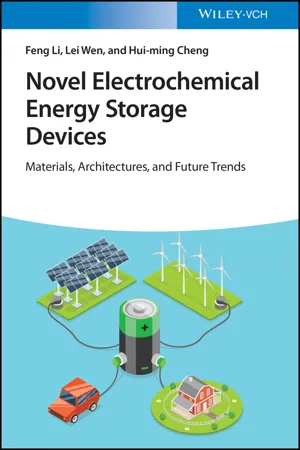
Novel Electrochemical Energy Storage Devices
Materials, Architectures, and Future Trends
- English
- ePUB (mobile friendly)
- Available on iOS & Android
Novel Electrochemical Energy Storage Devices
Materials, Architectures, and Future Trends
About this book
Explore the latest developments in electrochemical energy storage device technology
In Novel Electrochemical Energy Storage Devices, an accomplished team of authors delivers a thorough examination of the latest developments in the electrode and cell configurations of lithium-ion batteries and electrochemical capacitors. Several kinds of newly developed devices are introduced, with information about their theoretical bases, materials, fabrication technologies, design considerations, and implementation presented.
You'll learn about the current challenges facing the industry, future research trends likely to capture the imaginations of researchers and professionals working in industry and academia, and still-available opportunities in this fast-moving area. You'll discover a wide range of new concepts, materials, and technologies that have been developed over the past few decades to advance the technologies of lithium?ion batteries, electrochemical capacitors, and intelligent devices. Finally, you'll find solutions to basic research challenges and the technologies applicable to energy storage industries.
Readers will also benefit from the inclusion of:
- A thorough introduction to energy conversion and storage, and the history and classification of electrochemical energy storage
- An exploration of materials and fabrication of electrochemical energy storage devices, including categories, EDLCSs, pseudocapacitors, and hybrid capacitors
- A practical discussion of the theory and characterizations of flexible cells, including their mechanical properties and the limits of conventional architectures
- A concise treatment of the materials and fabrication technologies involved in the manufacture of flexible cells
Perfect for materials scientists, electrochemists, and solid-state chemists, Novel Electrochemical Energy Storage Devices will also earn a place in the libraries of applied physicists, and engineers in power technology and the electrotechnical industry seeking a one-stop reference for portable and smart electrochemical energy storage devices.
Frequently asked questions
- Essential is ideal for learners and professionals who enjoy exploring a wide range of subjects. Access the Essential Library with 800,000+ trusted titles and best-sellers across business, personal growth, and the humanities. Includes unlimited reading time and Standard Read Aloud voice.
- Complete: Perfect for advanced learners and researchers needing full, unrestricted access. Unlock 1.4M+ books across hundreds of subjects, including academic and specialized titles. The Complete Plan also includes advanced features like Premium Read Aloud and Research Assistant.
Please note we cannot support devices running on iOS 13 and Android 7 or earlier. Learn more about using the app.
Information
1
Introduction
1.1 Energy Conversion and Storage: A Global Challenge



Table of contents
- Cover
- Table of Contents
- Title Page
- Copyright
- Preface
- Abbreviations
- 1 Introduction
- 2 Materials and Fabrication
- 3 Flexible Cells: Theory and Characterizations
- 4 Flexible Cells: Materials and Fabrication Technologies
- 5 Architectures Design for Cells with High Energy Density
- 6 Miniaturized Cells
- 7 Smart Cells
- Index
- End User License Agreement